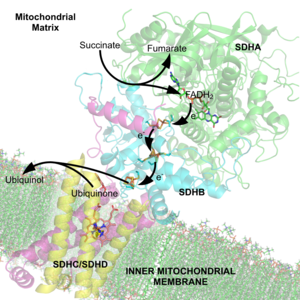
Back عامل مرافق (كيمياء حيوية) Arabic Кофактор Bulgarian Cofactor enzimàtic Catalan Kofaktor (biochemie) Czech Cofaktor Danish Cofaktor (Biochemie) German Συμπαράγοντας (βιοχημεία) Greek Cofactor Spanish Kofaktor Estonian کوفاکتور (بیوشیمی) Persian

A cofactor is a non-protein chemical compound or metallic ion that is required for an enzyme's role as a catalyst (a catalyst is a substance that increases the rate of a chemical reaction). Cofactors can be considered "helper molecules" that assist in biochemical transformations. The rates at which these happen are characterized in an area of study called enzyme kinetics. Cofactors typically differ from ligands in that they often derive their function by remaining bound.
Cofactors can be classified into two types: inorganic ions and complex organic molecules called coenzymes.[1] Coenzymes are mostly derived from vitamins and other organic essential nutrients in small amounts. (Some scientists limit the use of the term "cofactor" for inorganic substances; both types are included here.[2][3])
Coenzymes are further divided into two types. The first is called a "prosthetic group", which consists of a coenzyme that is tightly (or even covalently) and permanently bound to a protein.[4] The second type of coenzymes are called "cosubstrates", and are transiently bound to the protein. Cosubstrates may be released from a protein at some point, and then rebind later. Both prosthetic groups and cosubstrates have the same function, which is to facilitate the reaction of enzymes and proteins. An inactive enzyme without the cofactor is called an apoenzyme, while the complete enzyme with cofactor is called a holoenzyme.[5][page needed]
The International Union of Pure and Applied Chemistry (IUPAC) defines "coenzyme" a little differently, namely as a low-molecular-weight, non-protein organic compound that is loosely attached, participating in enzymatic reactions as a dissociable carrier of chemical groups or electrons; a prosthetic group is defined as a tightly bound, nonpolypeptide unit in a protein that is regenerated in each enzymatic turnover.[6]
Some enzymes or enzyme complexes require several cofactors. For example, the multienzyme complex pyruvate dehydrogenase[7] at the junction of glycolysis and the citric acid cycle requires five organic cofactors and one metal ion: loosely bound thiamine pyrophosphate (TPP), covalently bound lipoamide and flavin adenine dinucleotide (FAD), cosubstrates nicotinamide adenine dinucleotide (NAD+) and coenzyme A (CoA), and a metal ion (Mg2+).[8]
Organic cofactors are often vitamins or made from vitamins. Many contain the nucleotide adenosine monophosphate (AMP) as part of their structures, such as ATP, coenzyme A, FAD, and NAD+. This common structure may reflect a common evolutionary origin as part of ribozymes in an ancient RNA world. It has been suggested that the AMP part of the molecule can be considered to be a kind of "handle" by which the enzyme can "grasp" the coenzyme to switch it between different catalytic centers.[9]
- ^ Hasim, Onn H.; Adnan, Nor Azila (2010). "Coenzyme, Cofactor and Prosthetic Group — Ambiguous Biochemical Jargon" (PDF). Biochemical Education. 22 (2): 93–94. doi:10.1016/0307-4412(94)90088-4.
- ^ "Coenzymes and cofactors". Archived from the original on 1999-08-26. Retrieved 2007-11-17.
- ^ "Enzyme Cofactors". Archived from the original on 2003-05-05. Retrieved 2007-11-17.
- ^ Nelson DL, Cox MM (2008). Lehninger Principles of Biochemistry (Fifth ed.). New York: W.H. Freeman and Company. p. 184. ISBN 978-1429224161.
- ^ Sauke DJ, Metzler DE, Metzler CM (2001). Biochemistry: the chemical reactions of living cells (2nd ed.). San Diego: Harcourt/Academic Press. ISBN 978-0-12-492540-3.
- ^ de Bolster, M. W. G. (1997). Glossary of Terms Used in Bioinorganic Chemistry (PDF). Pure & Applied Chemistry.
- ^ Jordan F, Patel MS (2004). Thiamine: catalytic mechanisms in normal and disease states. New York, N.Y: Marcel Dekker. p. 588. ISBN 978-0-8247-4062-7.
- ^ "Pyruvate Dehydrogenase Complex". Chemistry LibreTexts. 2013-10-02. Retrieved 2017-05-10.
- ^ Cite error: The named reference
Denessioukwas invoked but never defined (see the help page).